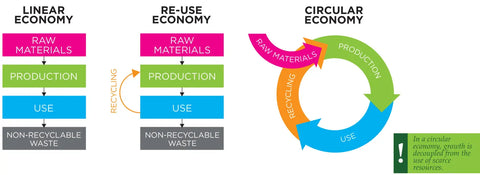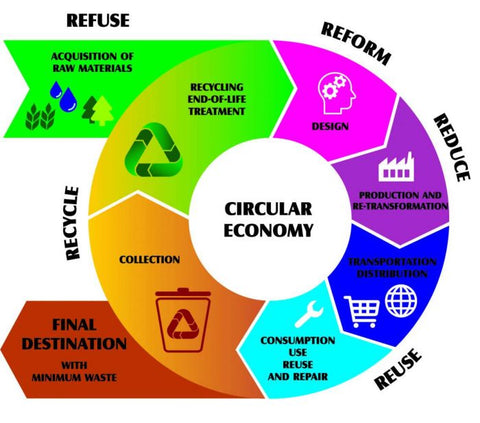Exploring Circular Economy Initiatives
Circular Economy in Action: Transforming Waste into Wealth
Circular Economy
Introduction: The circular economy is a sustainable approach to resource management that aims to minimize waste, reduce environmental impact, and maximize the value of products and materials. In this blog, we'll explore real-world examples of circular economy initiatives and provide insights on how to implement them in your business or community.

-
Product Lifecycle Extension: One of the fundamental principles of the circular economy is to extend the lifespan of products. Repair cafes, such as "The Repair Café," offer a practical solution. These community spaces provide tools, expertise, and a welcoming environment for people to repair their broken items, from electronics to clothing. Consider organizing similar events in your area to promote product longevity.
-
Recycling and Upcycling: The fashion industry is notorious for its waste and pollution. However, companies like Patagonia have embraced circularity by offering repair services for their products and recycling old materials to create new ones. To follow suit, educate yourself about recycling and upcycling techniques, and explore how to integrate them into your business or personal life.
-
Sharing Economy Platforms: Sharing economy platforms like Airbnb and Uber exemplify the circular economy by optimizing the use of existing resources. Consider starting or supporting local sharing initiatives, such as neighborhood tool libraries, to reduce the demand for new products and promote resource sharing within your community.
-
Waste-to-Energy Solutions: Biogas plants and waste-to-energy facilities convert organic waste into renewable energy. If you're interested in sustainable energy solutions, explore how you can support or invest in such projects, helping divert waste from landfills and generating green power.
-
Sustainable Packaging: Businesses are increasingly adopting sustainable packaging practices. Explore eco-friendly packaging alternatives like biodegradable materials or reusable containers. Encourage your favorite brands to prioritize sustainable packaging options.
-
Industrial Symbiosis: In Denmark, the Kalundborg Eco-Industrial Park demonstrates industrial symbiosis. Companies within the park exchange waste and resources, turning one company's byproduct into another's raw material. Collaborate with local businesses to establish similar symbiotic relationships and minimize waste.
-
Closed-Loop Supply Chains: Companies like IKEA are working on closed-loop supply chains, where products are designed for disassembly and materials are continually recycled. If you're in the business world, explore how your supply chain can be optimized to minimize waste and promote circularity.
-
Composting: Composting is a simple yet effective way to reduce organic waste. Start composting at home or advocate for community composting programs. The resulting compost enriches soil, supporting sustainable agriculture.
-
Transitioning to a circular economy involves rethinking traditional linear practices, where resources are extracted, used, and disposed of. This step-by-step guide will help you understand how to embrace the circular economy concept and integrate it into your lifestyle or business.
Step 1: Educate Yourself Start by gaining a thorough understanding of what the circular economy entails. Read books, articles, and watch documentaries about circular economy principles and success stories. Familiarize yourself with terms like "cradle-to-cradle," "product lifecycle," and "resource optimization."
Step 2: Assess Current Practices Evaluate your current lifestyle or business practices to identify areas where circularity can be applied. Are there opportunities to reduce waste, extend product lifecycles, or share resources more efficiently? Identify potential partners or organizations that align with your circular goals.
Step 3: Reduce and Reuse Prioritize waste reduction and reuse. Opt for products with extended warranties, repairability, and durability. Consider purchasing second-hand items or participating in swap meets and clothing exchanges. Encourage friends and family to adopt a similar mindset.
Step 4: Recycling and Upcycling Learn about proper recycling practices in your area. Create a recycling station at home or work to separate recyclables from general waste. Explore upcycling projects where you can repurpose items that might otherwise be discarded.
Step 5: Collaborate and Share Embrace the sharing economy by collaborating with others. Join community tool libraries, car-sharing services, or coworking spaces to share resources and reduce individual ownership. Support local businesses that prioritize circularity.
Step 6: Sustainable Purchasing Make informed decisions when buying products. Choose items with minimal packaging, made from recycled materials, or designed for easy disassembly and recycling. Support brands that are committed to circular practices.
Step 7: Composting Reduce organic waste by composting kitchen scraps and yard debris. Compost enriches soil and reduces the need for chemical fertilizers. If you lack space, explore community composting options or local drop-off locations.
Step 8: Advocate for Change Engage with your community and local government to advocate for circular economy initiatives. Support policies that promote sustainability, such as extended producer responsibility and eco-labeling. Encourage businesses to adopt circular practices.
Step 9: Measure Progress Track your progress in adopting circular economy principles. Set goals and measure waste reduction, resource optimization, and the positive environmental impact of your actions. Share your achievements with others to inspire change.
Step 10: Inspire Others Be an advocate for the circular economy. Share your knowledge and experiences with friends, family, and colleagues. Encourage them to join you on the journey toward a more sustainable and circular future.
Conclusion: Embracing the circular economy is a transformative process that benefits both individuals and the planet. By following these steps and continuously seeking opportunities for circularity, you can contribute to a more sustainable, waste-reducing, and resource-efficient world.

Decoupling growth from the use of scarce resources in a circular economy is a fundamental concept aimed at achieving economic prosperity while reducing the environmental impact and resource depletion traditionally associated with linear, "take-make-dispose" economic models. The key idea is to break the link between economic growth and the consumption of finite resources by promoting resource efficiency, recycling, and sustainable practices. Here's how it works:
-
Resource Efficiency: To decouple growth from resource use, businesses and industries must focus on optimizing resource consumption. This involves using fewer raw materials, energy, and water to produce goods and services. Strategies include improving production processes, adopting eco-design principles, and optimizing supply chains.
-
Circular Product Design: Design products with the entire lifecycle in mind. Ensure products are durable, repairable, and upgradable. Embrace modular design, which allows components to be easily replaced or upgraded, extending the product's life. This reduces the need for frequent replacements and conserves resources.
-
Waste Reduction: Minimize waste generation at every stage of the product's lifecycle. Encourage the use of recycled materials and promote the recycling of products at the end of their life. Implement waste-to-energy technologies to convert non-recyclable waste into energy.
-
Recycling and Reuse: Promote recycling as a means to recover valuable materials from discarded products. Create closed-loop systems where materials are collected, processed, and reintroduced into the production cycle. Encourage consumers and businesses to buy recycled products, closing the loop.
-
Sharing Economy: Encourage sharing and collaborative consumption models. Sharing assets like cars, tools, and office spaces reduces the overall demand for new products and resources. Platforms like ride-sharing, coworking spaces, and rental services exemplify this approach.
-
Resource Recovery: Invest in technologies and processes that allow the extraction of resources from waste streams. For example, recovering metals from electronic waste or extracting energy from organic waste through anaerobic digestion.
-
Eco-friendly Technologies: Embrace green technologies that reduce the environmental impact of production and consumption. This includes renewable energy sources, energy-efficient appliances, and sustainable transportation options.
-
Extended Producer Responsibility (EPR): Shift the responsibility for a product's entire lifecycle, including disposal, back to the manufacturer. Manufacturers are incentivized to design products that are easier to recycle, reuse, or dispose of sustainably.
-
Consumer Awareness: Educate consumers about the benefits of a circular economy and encourage responsible consumption. Consumers can make informed choices by purchasing products from companies that prioritize sustainability.
-
Policy and Regulation: Governments play a crucial role in promoting circular economy practices through policy development and regulation. This can include tax incentives for sustainable practices, setting recycling targets, and enforcing environmental standards.
-
Innovation: Invest in research and development to discover new ways of achieving resource efficiency and decoupling economic growth from resource use. Foster innovation in materials science, recycling technologies, and sustainable business models.
-
Collaboration: Collaboration among businesses, governments, NGOs, and consumers is essential for the successful transition to a circular economy. Cross-sector partnerships can drive innovation, share best practices, and create a supportive ecosystem for circular initiatives.
In summary, decoupling growth from resource use in a circular economy involves a holistic approach that encompasses sustainable product design, efficient resource utilization, waste reduction, recycling, and collaborative efforts. By implementing these strategies, economies can continue to grow and thrive while reducing their environmental footprint and reliance on finite resources.





Leave a comment